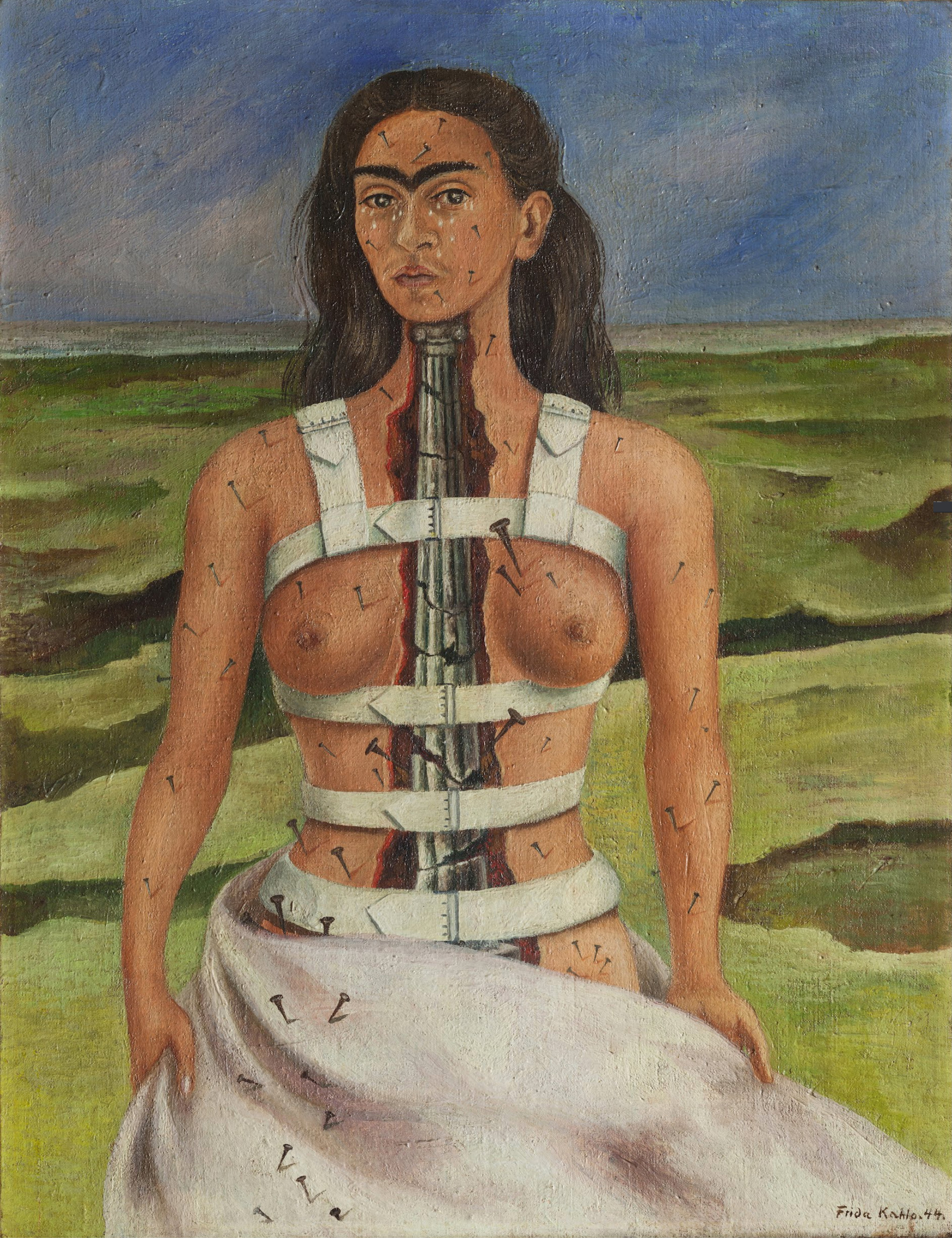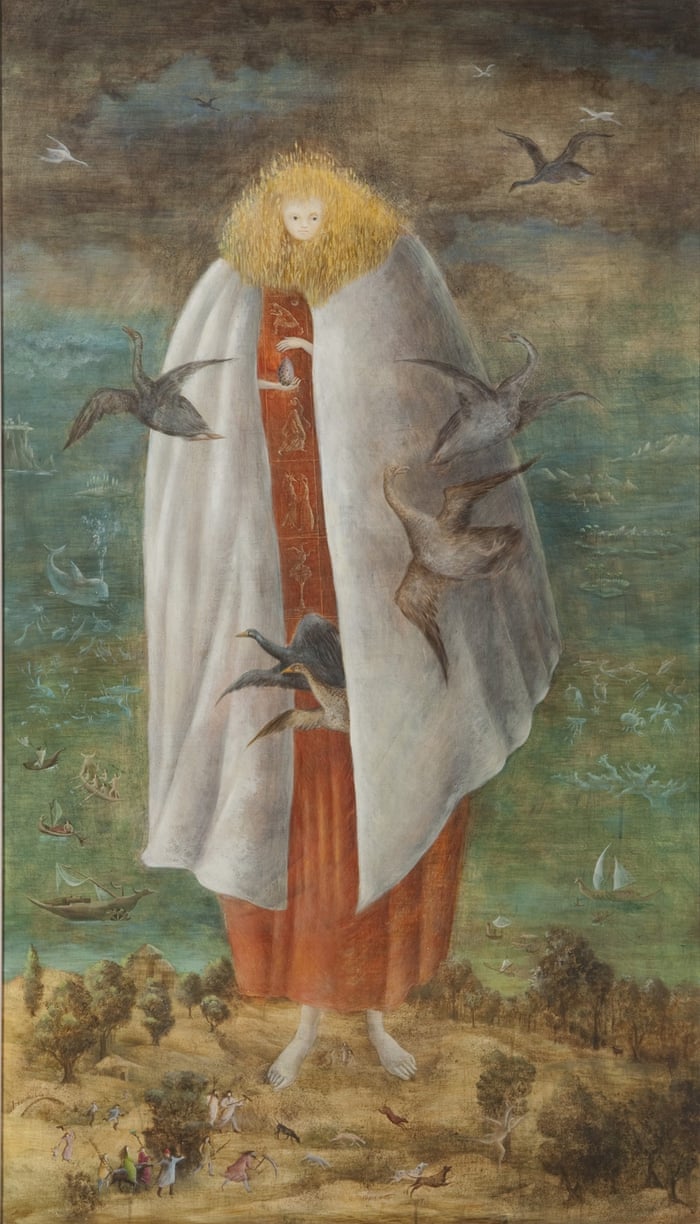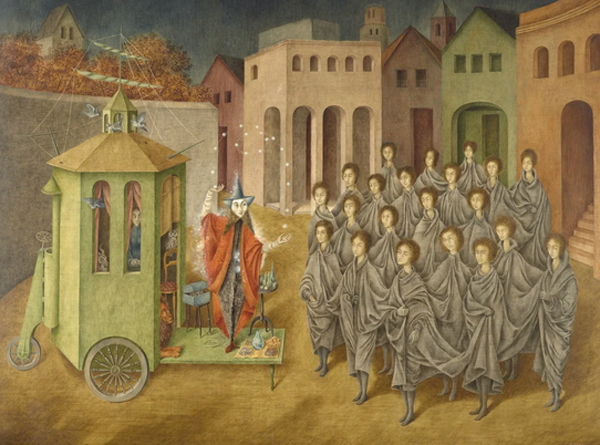The Women of Mexican Surrealism
Finding sanctuary in turbulent times.
- Kahlo created this piece after having surgery on her spine
- Like many of her self-portraits, it was a way to express her emotions through jarring and painful imagery
- Nails embedded into her skin give a new meaning to "pins-and-needles" as an expression for a specific feeling of pain a person can experience
- Her center is carved out, giving a feeling of intense exposure and bareness
- The column in her center is cracked and caving in, seeming to crumble and topple over to either side
- The metal bracing straps wrapped around her body feel like the only structure holding her together
- Being naked and exposed in this manner gives the viewer a greater understanding of how vulnerable it feels to live in a world of intense pain
- Tears streaming down her hopeless expression add to the helplessness felt in the piece
- The land behind her reads as empty, jagged, and flat, increasing the focal point of how exposed she is and the discomfort she must feel
- A coming-of-age piece produced by an artist with nothing short of a rebellious streak
- Carrington came from a very affluent family in Britain but fled home for Madrid and then to Mexico City in 1942, where she stayed until her passing in 2011
- The Giantess is a indeed giant, commanding the space of the image and drawing our eyes to her intricate details.
- Surrealism to Carrington spoke to her innate sense of rule-breaking, allowing her to provide an illustration of womanhood.
- Along the field in which she stands, hunters and wildlife are running about while the ships at sea float on the sea and melt into the scenery.
- The sky and the sea blend together in such a strange yet fluid manner
- The egg that the Giantess guards likely represents new life, while the halo surrounding the child-like cherub face reads as golden wheat, representing abundance
- The geese that fly about the giante4ss, emerging from her cloak, seem to be circling her
- The impish look on the giantess' face provides a notion that she knows what is happening and has full control of what is happening around her
- Varo and Carrington were good friends, having joined the same artists' guild for surrealism and other creative interests.
- The Magician in this piece is so undeniably peculiar, but as a viewer, I find it hard to look away from, much like the cloaked viewers inside the piece.
- The head of the magician is star-shaped, symbolizing balance and unity.
- The movement of the magician appears effortless, their body having an unnatural but magical glow and glitter to it.
- The crowd watches intently at the work of the magician, unable to break away.
- The cloaked figures indicate a shared lifestyle, perhaps even a cult, but they stand united as they watch the magician, looking on in wonder
- Even the buildings feel like they are drawing in close to witness the power of the magician.
Resources:
“The Broken Column.” Frida Kahlo, FridaKahlo.org, www.fridakahlo.org/the-broken-column.jsp. Accessed 8 Aug. 2024.
Enger, Reed. “The Broken Column.” Obelisk Art History, 6 Nov. 2022, www.arthistoryproject.com/artists/frida-kahlo/the-broken-column/.
“Frida Kahlo Paintings, Bio, Ideas.” The Art Story, www.theartstory.org/artist/kahlo-frida/. Accessed 8 Aug. 2024.
“The Giantess (The Guardian of the Egg).” Wikipedia, Wikimedia Foundation, 6 Oct. 2023, en.wikipedia.org/wiki/The_Giantess_(The_Guardian_of_the_Egg).
“HOW TO SEE | Surrealist Women Artists.” YouTube, The Museum of Modern Art, 21 Nov. 2020, youtu.be/1q4GNAQosy0.
“Leonora Carrington Paintings, Bio, Ideas.” The Art Story, www.theartstory.org/artist/carrington-leonora/. Accessed 8 Aug. 2024.
“Remedios Varo, The Juggler (The Magician).” MoMA, Museum of Modern Art, www.moma.org/collection/works/291307. Accessed 8 Aug. 2024.
“Surrealism.” MoMA, Museum of Modern Art, www.moma.org/collection/terms/surrealism. Accessed 8 Aug. 2024.
Urton, Robin. “Surrealism.” Eyecon Art, robinurton.com/history/surrealism.htm. Accessed 8 Aug. 2024.



Hi Marisa!
ReplyDeleteThis is an awesome topic for the more modern era of art - I think it is incredibly interesting how major conflicts like World War II influence and affect art. I had no idea Mexico was a safe haven for artists, and the pieces are amazing! The Broken Column is an extremely unique take on a self-portrait, and the story of Kahlo painting it post-surgery makes it all that much deeper to think about what she must have felt while painting it! Similarly, the Juggler is a very interesting surrealist piece because of how “magic” it feels - the colors and sparkles amongst an otherwise uniform world is a cool perspective! Thank you for sharing these pieces, and I hope you had a great semester!
-Andy